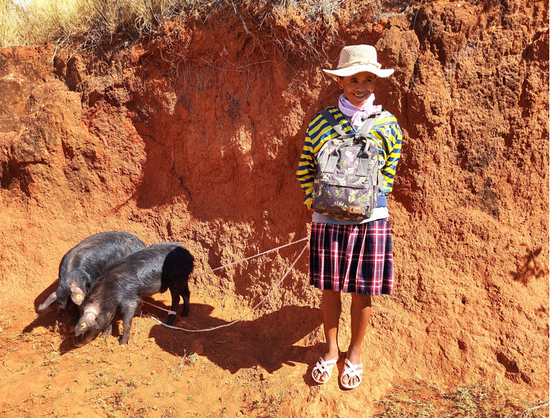
Taenia solium is a zoonotic parasite that circulates between people and pigs. In humans, it often leads to the disease neurocysticercosis, which is an important public health problem. This course provides a comprehensive, up-to-date, and ever-expanding toolkit containing practical, technical information (and relevant links) useful for the prevention, control and management of Taenia solium.
Photo credits: LVIF Madagascar
Language: English
English
Neurocysticercosis, Taenia solium
Course information
This course is also available in the following languages:
Overview: The parasite Taenia solium, which causes taeniasis and cysticercosis, is a zoonosis included in the WHO list of Neglected Tropical Diseases, and its transmission cycle involves humans and pigs. In humans, cysticercosis in the central nervous system is called neurocysticercosis and is the main cause of acquired epilepsy in many low-income countries. Despite the burden Taenia solium imposes on affected communities, epidemiological data are limited and there are very few active control programs. One Health programs involving interventions in humans and pigs are particularly effective. This course targets Taenia focal points in endemic countries and program managers and aims at providing them with the information and tools they need to start or strengthen their actions to tackle Taenia solium.
Course duration: Approximately 2 hours.
Certificate: A Certificate of Achievement will be issued to participants who score at least 80% of the total points available in all graded assessments. Participants who receive a certificate of achievement can also download an Open Badge for this course. Click here to learn how.
What you'll learn
- Describe the life cycle of T. solium, its transmission cycle, the diseases it causes and their impact;
- Identify T. solium endemic areas by using the Mapping tool;
- List the tools available for the control of T. solium in humans, pigs and the environment;
- Explain why a One Health approach is a more effective T. solium control strategy;
- List the diagnostics available to monitor T. solium in a public health program, and the basics of the monitoring and evaluation of public health programs;
- Recall the resources available to facilitate the case management of T. solium neurocysticercosis.
Course contents
Course Introduction:
This introductory module explains how to use this course and where to find the tools to use in the field.Module 1: Introduction to Taenia solium:
At the end of this module, you will: explain the T. solium transmission cycle; describe the diseases caused by the parasite and their impact; list the key risk factors and the basic prevention and control measures; and identify the main endemic regions.Module 2: Identification of Taenia solium endemic areas:
At the end of this module, you will: describe the T. solium mapping process; use the Mapping protocol and the Risk classification tool; and consider additional resources such as the focus group discussions and stakeholder surveys.Module 3: Preventive chemotherapy for taeniasis:
At the end of this module, you will: describe how to implement preventive chemotherapy to treat taeniasis in humans; monitor preventive chemotherapy coverage; prepare the annual working plan; prevent and manage neurological adverse events; and request a drug donation for preventive chemotherapy.Module 4: Monitoring and evaluation framework for Taenia solium:
At the end of this module, you will: list the T. solium diagnostics available for use in public health programs; know the suggested thresholds to trigger a public health program; use the monitoring and evaluation framework including mapping surveys and monitoring surveys; and list the indicators to monitor T. solium control programs at the global and country level.Module 5: Case management of neurocysticercosis:
At the end of this module, you will: explain how neurocysticercosis is acquired; recall WHO’s guidelines on the management of T. solium neurocysticercosis and the considerations for the use of anthelminthic therapy for the treatment of neurocysticercosis; and be acquainted with WHO’s resources on the management and treatment of epilepsy.Module 6: Prevention and control through One-Health:
At the end of this module, you will: explain the need for a One Health approach to T. solium control; outline the basics of pig interventions including pig vaccination, pig treatment and pig rearing practices; and discuss how food safety and WASH can contribute to the control of T. solium.Final Quiz
Enroll me for this course
Certificate Requirements
- Gain a Record of Achievement by earning at least 80% of the maximum number of points from all graded assignments.
- Gain an Open Badge by completing the course.